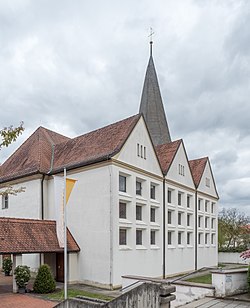|
Frensdorf
Frensdorf is a community in the Upper Franconian district of Bamberg. GeographyThe community lies in Upper Franconia south of Bamberg on the lower reaches of the Rauhe Ebrach. Constituent communitiesFrensdorf's main and namesake centre is the biggest of its Ortsteile with a population of 1,359, but this makes it only slightly bigger than Reundorf with 1,151. The community furthermore has these other outlying centres, each given here with its own population figure:
(as of 31 December 2006) The community also has four traditional rural land units, known in German as Gemarkungen, named Birkach, Frensdorf, Herrnsdorf and Reundorf, the same names as four of the constituent communities (it is traditional for a Gemarkung to be named after a town or village lying nearby). HistoryThe Lords of Abenberg made Frensdorf into the administrative hub of their holdings in the Bamberg area in the 12th century. They were, like the Andechs Meranians who followed them about 1190, Vögte (sing. Vogt – reeve) of the High Monastery at Bamberg, among whose holdings lay Frensdorf until the Reichsdeputationshauptschluss in 1803, since which time the community has belonged to Bavaria. Population developmentWithin municipal limits, 3,042 inhabitants were counted in 1970, 3,541 in 1987, 4,697 in 2000 and 4,687 in 2006. PoliticsThe mayor is Jakobus Kötzner (Aktive Wählerliste). The community council is made up of 20 members, listed here by party or voter community affiliation, and also with the number of seats that each holds, since the 2020 local elections:[3]
In 1999, municipal tax revenue, converted to euros, amounted to €1,545,000 of which business taxes (net) amounted to €178,000. Economy and infrastructureAccording to official statistics, there were 17 workers on the social welfare contribution rolls working in agriculture or forestry, 216 in producing businesses in 1998, and in trade and transport 33. In other areas, 81 workers on the social welfare contribution rolls were employed, and 1,732 such workers worked from home. In processing businesses there were two businesses, and in construction 11. Furthermore, in 1999, there were 117 agricultural operations with a working area of 2 674 ha, of which 2 674 ha was cropland and 445 ha was meadowland. EducationIn 1999, the following institutions existed in Frensdorf:
WingersdorfHistoryThe residential settlement of Wingersdorf is divided into the actual village and an estate, which was first mentioned in 1109 under the name Stöckach, and which until 1950 belonged to the Catholic parish of Herrnsdorf, whereas Wingersdorf belongs to the Catholic parish of Sambach. Throughout the community, the landlords were the Frensdorf administration, the Bamberg Chapter, the Collegiate Monastery of Saint Jacob at Bamberg, the Michaelsberg and St. Klara Monasteries at Bamberg, the Parish of Hirschaid, the Zollner von Brand, von Schönborn and Löffelholz von Colberg families and the community itself. The SchlösschenThe estate, whose history reaches back to 1109, is also known as the Wingersdorfer Schlösschen (“Wingersdorf Little Castle”). Its landlords and owners are known back to 1352. Its heyday began with its sale to the Bamberg book dealer Tobias Göbhardt on 26 October 1778 for 2,800 guilders. Göbhardt, who had also earned his money since 1764 reprinting books and who was therefore known at the Leipzig Trade Fair, held public offices from 1770 onwards, such as police court graduate lawyer and city councillor. He built on the estate's lands in 1778 and 1779 a building that dominated the whole valley. After his death, the Schlösschen remained in the Göbhardt family's hands until 1799, at which time they sold it to two members of the Winkler von Mohrenfels family. After frequent changes in ownership, the old Göbhardt manor ended up under the Burkard family's ownership. On New Year's Eve 1995-1996, a firework rocket struck the now empty Schlösschen. The fire that was thus started destroyed the roof truss, with the water from the firehoses also leaving stains. Because straw was being stored on the first floor and there was the danger of the fire's flaring up again from hotspots in the straw, parts of the outer walls had to be torn away so that the straw could more easily be removed. The owner was neither willing nor able to save the burnt ruins, and so the community council gave its consent in 2002 for the Baroque building's demolition. References
Further readingNorbert Haas: Tobias Göbhardt, Buchhändler in Bamberg und sein Besitztum in Wingersdorf External links |
||||||||||||||||||||||||||||||||||||||||||||||||||||||





